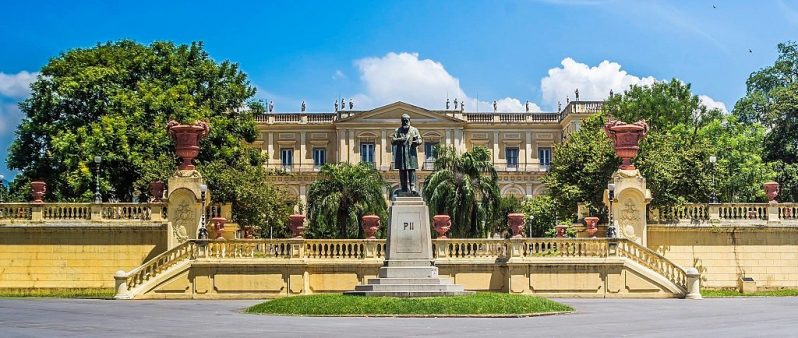
In one sense, a fire can destroy only what is tangible, but in Brazil’s National Museum fire, languages also perished. The only existing records of several Brazilian indigenous languages went up in flames. For the majority of these records, there were no digital backups. They are gone forever. So are the indigenous languages they described.
Languages Lost to Genocide
Like most language loss, this one is rooted in a colonial past. Since the year 1500, outsiders have killed, displaced, and enslaved the people native to what is now Brazil. Millions of people from thousands of distinct ethnic and linguistic groups died of infectious disease or were murdered. Those who survived were robbed of their homes, resources, and land.
Language loss is part of the genocide. The threatened groups’ languages are deemed gibberish, and it’s easier to maintain control if only the colonizer’s language is spoken. All of the Americas share a colonial past (and present), so none of these facts are unique to Brazil.
Documenting Indigenous Languages
In 1500, Brazil was home to at least 2,000 nations and tribes with their own languages. In 1997, about 200 of those were left. Many of the lost languages had no documentation. Language documentation is a record of a language and how it is used. Before tape recorders (or the even older wax cylinders), language documentation was written, and consisted of phonetic descriptions, word lists, sentences, and sometimes stories.
Modern language documentary materials depend on audio and video recordings, which provide much more detail, information, and accuracy than written documentation. In the past, linguists didn’t have the same resources or standards for archiving. Today, all documentary material of endangered languages is archived, though it’s only been required for National Science Foundation grant-receivers since 2011.
Sleeping Languages
While nothing can replace a healthy community with speakers of all ages, language documentation can help communities reclaim their languages. Languages which are no longer spoken are sometimes called ‘dead languages,’ but the preferred term is ‘sleeping’ or ‘dormant’ languages.
This sleeping metaphor highlights the ability of heritage speakers to reawaken or revitalize, their language. A sleeping language doesn’t have to stay sleeping. With sufficient documentation, a language can be spoken again, and any undocumented gaps can be creatively filled.
For example, Hebrew had no native speakers for centuries. But from 1882 to 1922, Hebrew experienced a revival and is now a national language that is spoken natively by millions.
And during the ‘Breath of Life Archival Institute for Indigenous California Languages’ and the ‘National Breath of Life Archival Institute for Indigenous Languages’, which are held in alternating years, indigenous North American languages are reclaimed and revitalized by their communities using archival documents.
Archives of indigenous American languages, like the California Language Archive or the Archive of the Indigenous Languages of Latin America, are crucial resources for indigenous communities that want to revitalize languages that are no longer spoken but which have written or audio documentation. Because of the real dangers of losing physical documentation, archives are turning to the digitization of materials.
This can be expensive and time-consuming but is necessary to prevent losses like that which happened in Brazil.
UNESCO’s Memory of the World Map
Bruna Franchetta, a linguist at the museum, said that part of the language collection had begun to be digitized. Perhaps she was referring to the Curt Nimuendajú Digital Library, a collection of digital documents relating to the languages and cultures of South America.
This library contains a large digital collection of the works of the eponymous ethnographer, including a digitized map of indigenous languages of Brazil and where they were spoken in the mid-1940s. The map is a monument registered by UNESCO’s Memory of the World Program; a beautifully-restored digital version can be viewed and downloaded here.
Sadly, the original map was destroyed in the fire, along with everything else. In a quote translated and posted by Diogo Almeida, Brazilian researcher Cinda Gonda remarked:
“Folks, there’s nothing left from the Linguistics division. We lost all the indigenous languages collection: the recordings since 1958, the chants in all the languages for which there are no native speakers alive anymore, the Curt Niemuendajú archives: papers, photos, negatives, the original ethnic-historic-linguistic map localizing all the ethnic groups in Brazil, the only record that we had from 1945.
The ethnological and archeological references of all ethnic groups in Brazil since the 16th century… An irreparable loss of our historic memory. It just hurts so much to see all in ashes.”
It appears that the language documentation archived at the National Museum was not yet being used for language reclamation or revitalization efforts. Now that the documentation is destroyed, that will never be possible.
An Irreparable Loss
Much of what was lost in the National Museum fire could not have been digitally preserved— fossils, artwork, archaeological artifacts, animal specimens, etc. Language documentation, however, could have been digitally archived so that no information would be lost. If researchers had the funding and resources to digitize their materials, the language loss could have been prevented.
While data from some indigenous languages of Brazil might be archived elsewhere, the majority of the linguistic material archived at the National Museum was completely unique. The destruction of these records represents language death in its utmost finality. As Brazil’s National Museum burned, dormant languages died in their sleep.
No Comments for "National Museum Fire ravages Brazil’s Indigenous Languages"